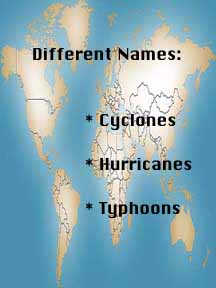From top to bottom: WC-130H Hercules, WP-3D Orion, Gulfstream IV-SP
WC-130H photo courtesy of the U.S. Air Force. WP-3D photo courtesy of NOAA/Brad Smull. Gulfstream IV-SP photo courtesy NOAA/AOC
Why the Different Airplanes?
Why do the 53rd Weather Reconnaissance Squadron and the Hurricane
Research Division use different airplanes? Actually, they only use two
main types. The top two airplanes in the graphic, the WC-130H Hercules and
the WP-3D Orion, are both turboprops. The bottom airplane in the graphic,
the Gulfstream IV-SP, is a turbofan.
The difference between a turboprop and a turbofan is more than just a few
letters. A turboprop is a propellor-driven aircraft. They are
well-suited for the slower speeds and low altitude (between 1,000 and
10,000 feet) flying associated with hurricane penetration. Both the WC-130H
and the WP-3D have four turboprop engines which allow them to stay in the
air from 8-12 hours (the WP-3D) up to 15 hours (the WC-130H).
A better-known term for a turbofan engine is a jet engine. A jet isn't as
economical as a prop at low altitudes and slow speeds but it is faster and
more economical at higher altitudes. Because of this, the Gulfstream
observes at a higher altitude (around 43,000 feet) around a hurricane.
Also, the greater speed allows for a greater operating radius so the
Gulfstream can record wind speed and direction away from the hurricane
itself. This information is needed make the forecasted
track more accurate.
You might also be interested in:

What types of instructional experiences help K-8 students learn science with understanding? What do science educators teachers, teacher leaders, science specialists, professional development staff, curriculum designers, school administrators need to know to create and support such experiences?
...more
The official "Hurricane Hunters" are the Air Force Reserve's 53rd Weather Reconnaissance Squadron. The squadron consists of ten WC-130 Hercules aircraft which are regularly flown through the eyes of hurricanes.
...more
Why do the 53rd Weather Reconnaissance Squadron and the Hurricane Research Division use different airplanes? Actually, they only use two main types. The top two airplanes in the graphic, the WC-130H Hercules
...more
Rain, wind, tornadoes, and storm surge related to hurricanes cause change to natural environments, damage to the human-built environment, and even loss of life. When a hurricane is over the ocean and far
...more
A cyclone is an area of low pressure with winds blowing counter-clockwise around it in the Northern Hemisphere and clockwise around it in the Southern Hemisphere. A tropical cyclone is a cyclone which
...more
Different places in the world call tropical cyclones by different names. If you click on the image at left you will see which areas use "cyclone", which use "hurricane", and which use "typhoon" when refering
...more
Here's a safe and easy way to make lightning. You will need a cotton or wool blanket. This experiment works best on a dry, cool night. Turn out all the lights and let your eyes adjust to the darkness.
...more
It takes 3 seconds for sound to travel 1 kilometer (5 seconds to travel 1 mile). The next time a thunderstorm comes your way, look out your bedroom window and watch for lightning. When you see a lightning
...more













